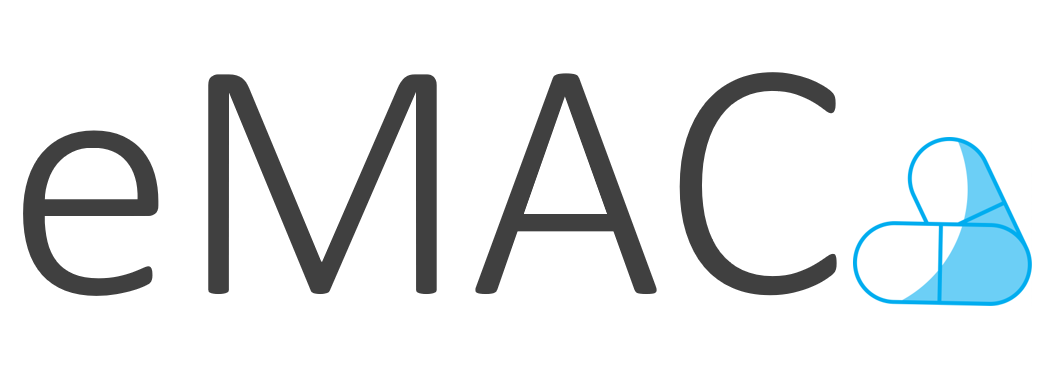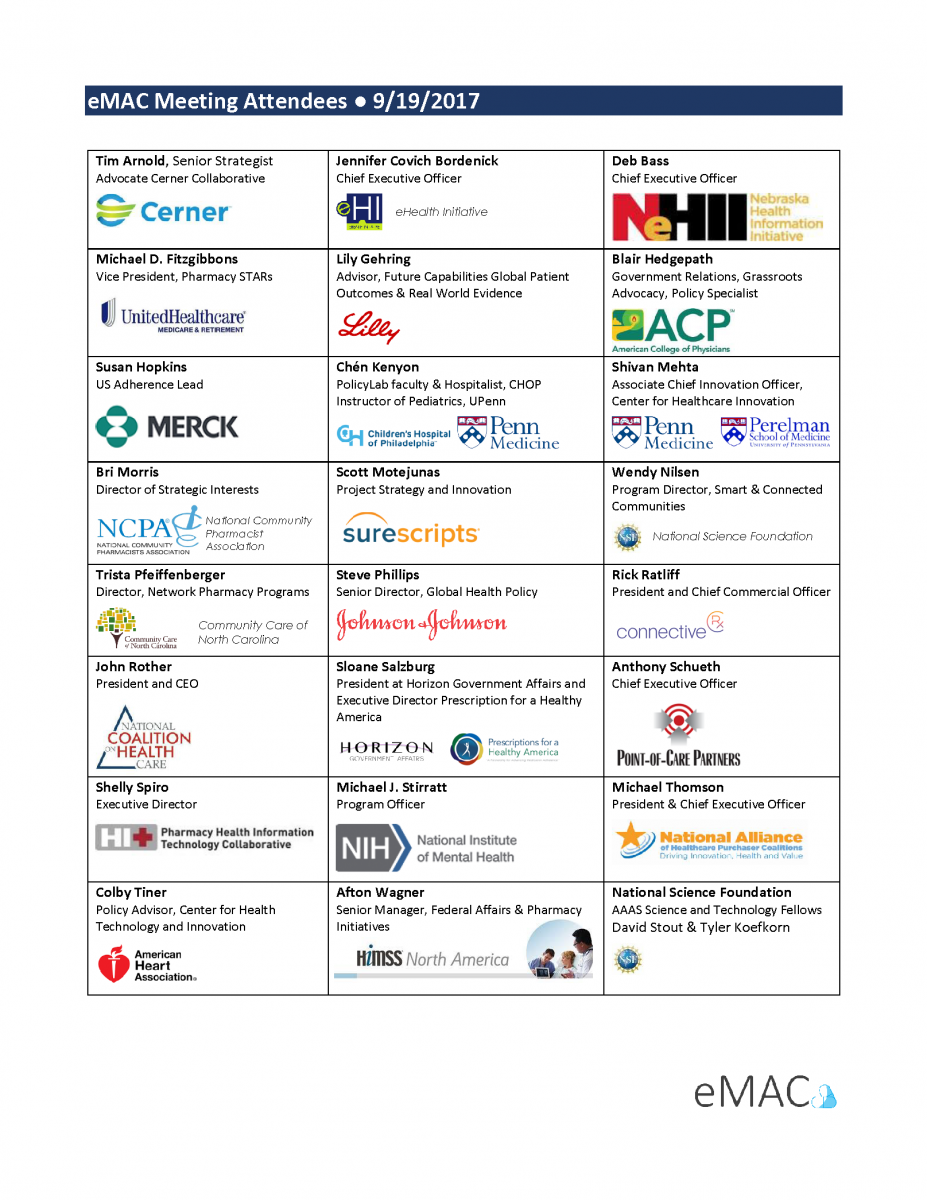eMAC 9.19.17 Roundtable Recap
eMAC 9.19.17 Roundtable Recap
Medication Adherence: Moving the Needle Forward
 On Tuesday, September 19, eHealth Initiative (eHI) convened more than 20 healthcare executives from payer, provider, academic, and pharmaceutical organizations for a roundtable discussion on medication adherence—a patient’s ability to take medication exactly as prescribed. The roundtable was the first in-person meeting of eHI’s Electronic Medication Adherence Collaborative (eMAC). eMAC brings together stakeholders who are using analytical and behavioral interventions to address adherence. Through this initiative, eHI is capturing best practice data to move healthcare closer to a culture of medication adherence.
On Tuesday, September 19, eHealth Initiative (eHI) convened more than 20 healthcare executives from payer, provider, academic, and pharmaceutical organizations for a roundtable discussion on medication adherence—a patient’s ability to take medication exactly as prescribed. The roundtable was the first in-person meeting of eHI’s Electronic Medication Adherence Collaborative (eMAC). eMAC brings together stakeholders who are using analytical and behavioral interventions to address adherence. Through this initiative, eHI is capturing best practice data to move healthcare closer to a culture of medication adherence.

In 2004, one of eHI’s major initiatives was the nascent concept of electronic prescribing. eHI became an instrumental force in making e-prescribing a mainstream practice. Now, more than 70% of physicians are e-prescribing and 90% of pharmacies accept e-prescriptions, according to the Office of the National Coordinator for Health Information Technology (ONC) data. eMAC is designed to have a similar impact on medication adherence.
Now is the time
Medication non-compliance, or non-adherence, has traditionally been detrimental to population health. Non-adherence contributes to negative health outcomes, poor quality of life, and increased medical costs. In the current healthcare environment, there are numerous financial incentives around value-based care and patient outcomes. Improving medication adherence improves patient outcomes and lowers healthcare costs.
 Payers and providers are poised to capitalize on the wealth of data and resources that simply did not exist a few years ago. At this critical juncture, eMAC’s goal is to create a standardized system, a “vital sign,” based on data sharing, to address the multi-faceted and dynamic nature of medication adherence. While there is no magic pill to cure non-adherence, through collaboration and data sharing, the needle will move forward.
Payers and providers are poised to capitalize on the wealth of data and resources that simply did not exist a few years ago. At this critical juncture, eMAC’s goal is to create a standardized system, a “vital sign,” based on data sharing, to address the multi-faceted and dynamic nature of medication adherence. While there is no magic pill to cure non-adherence, through collaboration and data sharing, the needle will move forward.
Sharing the data
The September 19 meeting was an engaging discussion with eMAC stakeholders, focused on emerging best practices and studies. Currently refill rates, active and passive drug monitoring, patient reports, and pharmacy insurance claims are the various tools used to track adherence. Adherence occurs on a changing spectrum that includes high, moderate, low, and mixed. Stakeholders discussed the various findings of research conducted by their organizations and what they have learned from the research of other groups
|
“Supplements are the dirty little secrets that effect adherence.” |
The consensus was a need for system and individual level initiatives to address medication adherence. A summary of practices that members of the collaborative deemed to have a positive impact on adherence, and some that did not, follows.
Links in this article are located in the Medication Adherence section of eHI’s Ehealth Resource Center, which contains additional information on each aspect of medication adherence listed below.
clinical contact x technology x behavior change =
sustained health outcomes
Positively Impacts Medication Adherence
- Patient education with behavioral support
- Case management
- Reducing co-pays, patients leaving with medication in hand, and otherwise helping with costs
- Blister packs (multiple medications packaged together for use at the same time)
- Self-management initiatives
- Managing medication side effects
- Increasing patient motivation
- Decreasing medication stigma
- Personalized medication reminders, specifically interactive reminders, and other targeted interventions
- Medication Therapy Management (MTM), such as those coupled with Medicare Part D
- Providing Medicare A/B data part D plans
- Medication reconciliation that ceases unnecessary prescriptions
- Fewer medications [Can an illness be treated with one pill instead of two?]
- Patient baseline and continued measurements
- Easy to understand medication instructions
- Pharmacist Health Information Technology and mobile health integration
- Pharmacist engagement with patients, particularly through community pharmacies
- Granting pharmacies “provider” status
- Shared incentives for physicians and patients
- On-site health center pharmacies
- Tablet based adherence survey for patients that is a part of the clinical workflow
- 3-question adherence estimator, a conversation starter for providers to dig deeper with patients
- Stable routine for children requiring medication
Little to No impact on Medication Adherence
- Simple reminder devices (standard pillbox, digital timer cap, pill bottle caps that track times opened)
- Education only
- Shaming patients for non-adherence (finger wagging)
- Mailings
- Phone calls
Next Steps
On December 12, 2017, eMAC will reconvene to work on the vital sign for medication adherence. As with e-prescribing, medication adherence should be incorporated into each doctor visit. There are many components to adherence. Did the patient take the correct dosage? Was the medication taken at the right time of day and for the length of time prescribed for use? As demonstrated from our discussion, a body of research already exists on validated self-report questions and other indirect methods to capture adherence.
Using this data, the vital sign is intended to be a simple tool to track adherence, while addressing root causes of the many barriers to compliance, such as stigma, resources / access, side effects, and trust. The tool will help providers better manage their Medicare Access and CHIP Reauthorization Act (MACRA) needs being implemented by the Centers for Medicare & Medicaid Services. Improving adherence improves patient outcomes, which ultimately saves the healthcare industry money.

